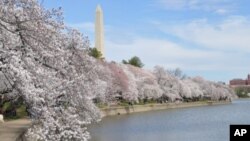A gift of friendship from Japan nearly a century ago is in full bloom here in Washington. This time each year, thousands of cherry trees display white and pink flowers throughout the city, and prominently around the Tidal Basin near the Washington Monument and next to the Jefferson and Roosevelt Memorials. The event this year comes as Japan struggles to overcome effects from a huge earthquake and tsunami.
The Spring season in Washington is highlighted by the blooming of cherry trees and a festival that runs for 16 days.
"The Cherry Blossom Festival is the (U.S. National) Park Service's biggest event over the course of the year. The single biggest event is the Fourth of July. But the biggest (overall) event is the Cherry Blossom Festival," said Steven Hanneker of the National Park Service, who greets visitors and tells them about the trees. In 1912, Japan sent the first small group of trees to Washington as a gift. Those trees turned out to be diseased, and President William Taft reluctantly ordered then to be burned. A second shipment arrived.
"Those trees were good enough to pass inspection of the Department of Agriculture. They started planting them in 1912. This spot right here marks where the first two were planted. Mrs. Taft planted the first one," he said.
Former U.S. Ambassador John Malott heads the Japan-America Society. He marvels how the area was transformed into one of the most recognizable images of Washington and the United States. "This is where it all started. There was nothing but the water. Mrs. Taft and the wife of the Japanese Ambassador came down and they planted two trees. And look what it has become today. So just from those two trees it was a great act of faith and it created one of the most famous scenes in the country," he said.
Ambassador Malott says many trees from the first planting remain. "There are still 100 trees there that are from the original group in 1912. So that is a tribute to the Park Service which has taken such good care of the trees over the years. You can sort of tell which are the originals because they are kind of big and gnarly. If they bloom, they bloom at the top and not at the sides," he said.
An ancient Japanese lantern stands in the shadows among the old trees stands.
"The lantern is about 350 years old. It is about three meters tall. I think it weighs around 1,400 kilograms. It was created upon the death of the third shogun, or feudal ruler of Japan. It is one of a pair. The other one is still in Tokyo. It was given to us in 1954 to commemorate the 100th anniversary of the opening of Japan," said Malott.
This year the air is crisp. Cool weather has not deterred the cherry trees in Washington from blooming, but it may shorten their annual glory. Typically, the cherry blossoms are out for about two weeks. But the peak viewing time is now, and that only lasts a precious few days.
But for about two weeks, performers a short distance away at the Washington monument showcase traditional Japanese music and dance.
"This dance was taught to us the Sunday before the earthquake. We had exchange students from Japan, from the Tokyo area. It just is really, really special to us," said one performer.
Back at the Tidal Basin, Steven Hanneker of the National Park Service says the cherry trees not only were a gift from Japan, but have been a gift back to the Asian nation from the United States in previous times of turmoil.
"What may not be good at one point in history you can change things and make relationships better again. The cherry trees have been a good ambassador in that respect, in terms of that cultural exchange going back and forth. It has been a two way exchange. We have given their trees back to them at times when they needed them, after World War II and again after a flood in 1982," he said.
To observe the centennial of the trees next year, Ambassador Malott says another gift is on its way to Japan now.
"The Park Service took 144 clippings from these original trees. They were sent to Japan where eventually they will go to the Japanese Cherry Blossom Association. They will be grafted on to tree stalk in Japan. So they will become 100-percent clones of the original trees. And so the original trees go back to Japan this year, hopefully will bloom next year," he said.
The blooms from the original trees next year in Japan will no doubt hold special significance as a rebirth of life one year after the devastating earthquake and tsunami. Money for aid to the victims in Japan is being raised throughout the 16-day Cherry Blossom Festival in Washington.
Hundreds of people also took part in a march along the Tidal Basin just ahead of the festival to raise awareness and money. The devastation in Japan has been compounded by radioactive fallout from a damaged nuclear power plant, making the need for donations more urgent.
Photos by VOA's Jim Stevenson
Related video report by June Soh:
